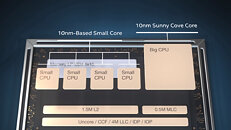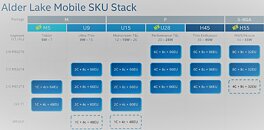- Joined
- Aug 19, 2017
- Messages
- 2,999 (1.07/day)
As we are getting closer to the launch of Intel's next-generation Alder Lake processors, more information is getting leaked. Today, thanks to the leaked presentation slide, we have some more details regarding Intel's Alder Lake offerings in the laptop sector. As a reminder, Alder Lake uses a hybrid approach to core configuration with the similar mindset Arm's big.LITTLE works. There are a few smaller cores for processing smaller tasks that don't need much power and, of course, there are a few big cores that are used for heavyweight processing as some advanced applications require. The small cores are going to be based on the Gracemont microarchitecture, while the big one will use the Golden Cove design.
Thanks to @9550pro on Twitter, we have a slide that showcases 19 different Alder Lake configurations for the laptop segment. At the very bottom, there are configurations with a TDP of just five Watts. That is achieved by having just one big, four smaller cores, 48 EU Gen 12 GPU and that is meant for the tablet segment. Going up, we have different ranges depending on the application device, and the highest end is a chip with 55 Watts of power. That model has eight small and eight big cores, combined with 32 EUs of Gen 12 graphics. All models include integrated graphics. The variations of big and small cores have allowed Intel to have as many as 19 different SKUs, that cover every segment needed, by simply balancing the core count. You can check out the rest of the models below for yourself.


View at TechPowerUp Main Site
Thanks to @9550pro on Twitter, we have a slide that showcases 19 different Alder Lake configurations for the laptop segment. At the very bottom, there are configurations with a TDP of just five Watts. That is achieved by having just one big, four smaller cores, 48 EU Gen 12 GPU and that is meant for the tablet segment. Going up, we have different ranges depending on the application device, and the highest end is a chip with 55 Watts of power. That model has eight small and eight big cores, combined with 32 EUs of Gen 12 graphics. All models include integrated graphics. The variations of big and small cores have allowed Intel to have as many as 19 different SKUs, that cover every segment needed, by simply balancing the core count. You can check out the rest of the models below for yourself.


View at TechPowerUp Main Site


 Transparency to the buyer is what im looking for!
Transparency to the buyer is what im looking for!





 About three for each form factor.
About three for each form factor.